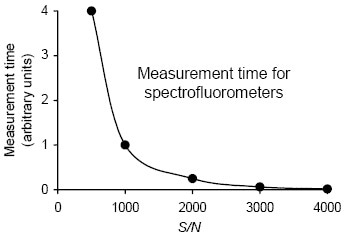Sponsored by HORIBAAug 15 2005
Be sure that sensitivity calculations are identical for a valid comparison. HORIBA conservatively quotes a minimum signal-to-noise ratio (S/N) of 2500:1 for the FluoroMax®. In 2001, the average FluoroMax® S/N was closer to 5000:1, and no instrument was shipped with a S/N below 3000:1. Compare this to other manufacturers who quote 500:1.
Let us compare experimental conditions. HORIBA calculates S/N via a water-Raman test with 5-nm bandpass. Other companies use a 10-nm bandpass on both emission and excitation monochromators. This lets twice the light into each monochromator and twice the light out, a factor of four for each monochromator, and 16 for the entire instrument. Thus, the other companies’ data are inflated by more than an order of magnitude. The S/N varies as the square root of the signal. Therefore, under similar conditions, the seemingly respectable number of 500:1 is actually closer to 100:1!
So, What Does This Mean For You?
Certainly the main indicator of sensitivity is the ability to examine lower concentrations. For expensive samples, you need less sample or you consume less probe. Yet there are two other advantages of sensitivity: accuracy and measurement time.
Measurement Time
When comparing data with other firms, consider that the square root of the measured number of photons determines the S/N. If two instruments have a S/N difference of a factor of two, one will actually take four times longer than the other to measure the same signal.
Accuracy
The final measurement is only as good as the amount of data going in. To count photons with 1% accuracy, you need at least 10 000 photons. We assume random error and Gaussian statistics, so that the first standard deviation equals the square root of the measured number.

Figure 1. First Standard Deviation Equation
Quality of electronics does not matter: without 10 000 photons, the accuracy cannot be 1%. (Analog detection has other problems, e.g., hidden noise in the signal, and response times that skew the data.) Hence, an instrument with twice the S/N is twice as accurate under the same conditions.

Figure 2. Spectrofluorometer Measurement Time
Where Does Sensitivity Come From?
If everyone needs sensitivity, why doesn’t everyone have it? It’s a question of economics and quality. Photon-counting electronics, reflective (mirror-based) rather than refractive (lens-based) optics, planar instead of concave gratings, full instrument automation, and all the other high-quality components of a HORIBA spectrofluorometer are more expensive. Thus, an accurate, time-saving, sensitive instrument is worth more than one that is not. How much is your research worth?

This information has been sourced, reviewed and adapted from materials provided by HORIBA.
For more information on this source, please visit HORIBA.